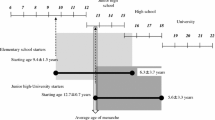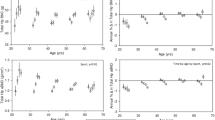Abstract
Summary
Young recreational and precompetitive gymnasts had, on average, 23% greater bone strength at the wrist compared to children participating in other recreational sports. Recreational gymnastics involves learning basic movement patterns and general skill development and as such can easily be implemented into school physical education programs potentially impacting skeletal health.
Introduction
Competitive gymnasts have greater bone mass, density, and estimated strength. The purpose of this study was to investigate whether the differences reported in the skeleton of competitive gymnasts are also apparent in young recreational and precompetitive gymnasts.
Methods
One hundred twenty children (29 gymnasts, 46 ex-gymnasts, and 45 non-gymnasts) between 4 and 9 years of age (mean = 6.8 ± 1.3) were measured. Bone mass, density, structure, and estimated strength were determined using peripheral quantitative computed tomography at the distal (4%) and shaft (65%, 66%) sites in the radius and tibia. Total body, hip, and spine bone mineral content (BMC) was assessed using dual energy X-ray absorptiometry. Analysis of covariance (covariates of sex, age and height) was used to investigate differences in total bone content (ToC), total bone density (ToD), total bone area (ToA), and estimated strength (BSI) at the distal sites and ToA, cortical content (CoC), cortical density (CoD), cortical area (CoA), cortical thickness, medullary area, and estimated strength (SSIp) at the shaft sites.
Results
Gymnasts and ex-gymnasts had 5% greater adjusted total body BMC and 6-25% greater adjusted ToC, ToD, and BSI at the distal radius compared to non-gymnasts (p < 0.05). Ex-gymnasts had 7-11% greater CoC and CoA at the radial shaft and 5-8% greater CoC and SSIp at the tibial shaft than gymnasts and non-gymnasts. Ex-gymnasts also had 12-22% greater ToC and BSI at the distal tibia compared to non-gymnasts (p < 0.05).
Conclusion
This data suggests that recreational and precompetitive gymnastics participation is associated with greater bone strength.



Similar content being viewed by others
References
Daly RM, Rich PA, Klein R, Bass S (1999) Effects of high-impact exercise on ultrasonic and biochemical indices of skeletal status: a prospective study in young male gymnasts. J Bone Miner Res 14:1222–1230
Proctor KL, Adams WC, Shaffrath JD, Van Loan MD (2002) Upper-limb mineral density of female collegiate gymnasts versus controls. Med Sci Sport Exercise 34:1830–1835
Robinson TL, Snow-Harter C, Taaffe DR, Gillis D, Shaw J, Marcus R (1995) Gymnasts exhibit higher bone mass than runners despite similar prevalence of amenorrhea and oligmenorrhea. J Bone Miner Res 10:26–35
Bass S, Pearce G, Bradney M, Hendrich E, Delmas PD, Harding A, Seeman E (1998) Exercise before puberty may confer residual benefits in bone density in adulthood: studies of active pre-pubertal and retired female gymnasts. J Bone Miner Res 13:500–507
Scerpella TA, Davenport M, Morganti CM, Kanaley JA, Johnson LM (2003) Dose related association of impact activity and bone mineral density in pre-pubertal girls. Calcif Tissue Int 72:24–31
Dowthwaite JN, Scerpella TA (2009) Skeletal geometry and indices of bone strength in artistic gymnasts. J Musculoskelet Neuronal Interact 9:198–214
Daly RM, Caine D, Bass SL, Pieter W, Broekhoff J (2005) Growth of highly vs moderately trained competitive female artistic gymnasts. Med Sci Sport Exerc 37:1053–1060
Dyson K, Blimkie CJ, Davidson SK, Webber CE, Adachi JD (1997) Gymnastics training and bone density in pre-adolescent females. Med Sci Sport Exerc 29:443–450
Ward KA, Roberts SA, Adams JE, Mughal MZ (2005) Bone geometry and density in the skeleton of pre-pubertal gymnasts and school children. Bone 36:1012–1018
Eser P, Hill B, Ducher G, Bass SL (2009) Skeletal benefits after long-term retirement in former elite female gymnasts. J Bone Miner Res 12:1981–1988
Laing EM, Wilson AR, Modlesky CM, O’Conner PJ, Hall DB, Lewis RD (2005) Initial years of recreational gymnastics training improves lumbar spine bone mineral accrual in 4- to 8-year-old gymnasts. J Bone Miner Res 20:509–519
International Standards for Anthropometric Assessment (2001) International Society for the Advancement of Kinanthropometry, Australia.
Mirwald RL, Baxter-Jones ADG, Bailey DA, Beunen GP (2002) An assessment of maturity from anthropometric measurements. Med Sci Sport Exerc 34:689–694
Montoye HJ, Kemper HCG, Saris WHM, Washburn RA (1996) Measuring physical activity and energy expenditure. Human Kinetics, Champagin IL
Janz KF, Broffitt B, Levy SM (2005) Validation evidence for the Netherlands Physical Activity Questionnaire for young children: The Iowa Bone Development. Study Res Quart Exerc Sport 76:363–369
Whiting SJ, Shrestha RK (1993) Dietary assessment of elementary school-aged children and adolescents. J Can Diet Assoc 54:193–196
XCT (2000) Manual (2007) Stratec Medizintechnik GmbH. Pforzhemin, Germany
Lochmuller EM, Lill CA, Kuhn V, Schneider E, Eckstein F (2002) Radius bone strength in bending, compression and falling and its correlation with clinical densitometry at multiple sites. J Bone Miner Res 17:1629–1638
Kontulainen SA, Johnston JD, Liu D, Leung C, Oxland TR, McKay HA (2008) Strength indices from pQCT imaging predict up tp 85% of variation in bone failure properties at tibal epiphysis and diaphysis. J Musculoskel Neur Interact 8:401–409
Dowthwaite JN, Flowers PP, Spadaro JA, Scerpella (2007) Bone geometry, density and strength indices of the distal radius reflect loading via childhood gymnastics activity. J Clin Densitom 10:65–75
Dowthwaite JN, Kanaley JA, Spardaro JA, Hickman RM, Scerpella TA (2009) Muscle indices do not fully account for enhanced upper extremity bone mass and strength in gymnasts. J Musculoskel Neuronal Interact 9:2–14
Laing EM, Massoni JA, Nicols-Richardson SM, Modlesky CM, O’Conner PJ, Lewis RD (2002) A prospective study of bone mass and body composition in female adolescent gymnasts. J Ped 141:211–216
Pollock NK, Laing EM, Modlesky CM, O’Conner PJ, Lewis RD (2006) Former college artistic gymnasts maintain higher BMD: a nine year follow-up. Osteoporos Int 17:1691–1697
Faulkner RA, Forwood MR, Beck TJ, Mafukidze JC, Russell K, Wallace W (2003) Strength indices of the proximal femur and shaft in prepubertal female gymnasts. Med Sci Sport Exerc 35:513–518
Zanker CL, Gannon L, Cooke CB, Gee KL, Oldroyd B, Truscott JG (2003) Difference in bone density, body composition, physical activity and diet between child gymnasts and untrained children 7-9 years of age. J Bone Miner Res 18:1043–1050
Goulding A, Jones IE, Taylor RW, Manning PJ, Williams SM (2000) More broken bones: a 4-year double cohort study of young girls with and without distal forearm fractures. J Bone Miner Res 15:2001–2018
Rennie L, Court-Brown CM, Mok JYQ, Beattie TF (2007) The epidemiology of fractures in children. Injury: Int J Care Inj 38:913–922
Zemel B, Bass S, Binkley T, Ducher G, Macdonald H, McKay H, Moyer-Mileur L, Shepherd J, Specker B, Ward K, Hans D (2008) Peripheral quantitative computed tomography in children and adolescents: the 2007 ISCD official positions. J Clin Densitomet: Assessment of Skeletal Health 11:59–74
Acknowledgments
The authors gratefully acknowledge the study participants and their families for their enthusiasm and commitment to the project. The authors would also like thank Dr. Phil Chilibeck for his assistance with manuscript preparation, Stefan Jackowski for his assistance with measurements, and Joelle Schafer for analyzing the pQCT muscle data. This study was supported in part by funding from the Canadian Institute of Health Research (CIHR).
Conflicts of interest
None
Author information
Authors and Affiliations
Corresponding author
Rights and permissions
About this article
Cite this article
Erlandson, M.C., Kontulainen, S.A. & Baxter-Jones, A.D.G. Precompetitive and recreational gymnasts have greater bone density, mass, and estimated strength at the distal radius in young childhood. Osteoporos Int 22, 75–84 (2011). https://doi.org/10.1007/s00198-010-1263-9
Received:
Accepted:
Published:
Issue Date:
DOI: https://doi.org/10.1007/s00198-010-1263-9




